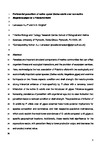Preferential parasitism of native oyster Ostrea edulis over non-native Magallana gigas by a Polydorid worm
| dc.contributor.author | Lemasson, A | |
| dc.contributor.author | Knights, A | |
| dc.date.accessioned | 2019-04-04T10:29:09Z | |
| dc.date.issued | 2019-05-09 | |
| dc.identifier.issn | 1559-2723 | |
| dc.identifier.issn | 1559-2731 | |
| dc.identifier.uri | http://hdl.handle.net/10026.1/13631 | |
| dc.description.abstract |
Parasites are important structural components of marine communities that can affect organism fitness and ecological interactions, and the provision of ecosystem services. Here, we investigate the host association of Polydora ciliata with two ecologically and economically important oyster species (Ostrea edulis; Magallana gigas) and examine its impacts on two fitness aspects: condition and shell strength. Our results provide strong inferential evidence of host-specificity by P. ciliata with a tendency toward infestation of the native O. edulis over the introduced M. gigas. Evidence suggests increasing prevalence of parasitism with organismal age, but no clear indication that parasitism leads to reduced condition or shell strength. The prevalence of infection of O. edulis by P. ciliata over M. gigas observed here holds potential implications for species competition and dominance, and their respective population maintenance, which could explain the much lower abundances of O. edulis compared to M. gigas at specific geographical locations. Additionally, these results hold significance for the aquaculture sector, with parasitism likely to lower production output and decrease the end-product market value | |
| dc.format.extent | 1397-1403 | |
| dc.language | en | |
| dc.language.iso | en | |
| dc.publisher | Springer Verlag | |
| dc.subject | estuary | |
| dc.subject | intertidal | |
| dc.subject | non-native species | |
| dc.subject | aquaculture | |
| dc.subject | ecological interactions | |
| dc.title | Preferential parasitism of native oyster Ostrea edulis over non-native Magallana gigas by a Polydorid worm | |
| dc.type | journal-article | |
| dc.type | Article | |
| plymouth.author-url | https://www.webofscience.com/api/gateway?GWVersion=2&SrcApp=PARTNER_APP&SrcAuth=LinksAMR&KeyUT=WOS:000469363100013&DestLinkType=FullRecord&DestApp=ALL_WOS&UsrCustomerID=11bb513d99f797142bcfeffcc58ea008 | |
| plymouth.issue | 5 | |
| plymouth.volume | 42 | |
| plymouth.publication-status | Published | |
| plymouth.journal | Estuaries and Coasts | |
| dc.identifier.doi | 10.1007/s12237-019-00560-y | |
| plymouth.organisational-group | /Plymouth | |
| plymouth.organisational-group | /Plymouth/Faculty of Science and Engineering | |
| plymouth.organisational-group | /Plymouth/Faculty of Science and Engineering/School of Biological and Marine Sciences | |
| plymouth.organisational-group | /Plymouth/REF 2021 Researchers by UoA | |
| plymouth.organisational-group | /Plymouth/REF 2021 Researchers by UoA/UoA07 Earth Systems and Environmental Sciences | |
| plymouth.organisational-group | /Plymouth/Users by role | |
| plymouth.organisational-group | /Plymouth/Users by role/Academics | |
| plymouth.organisational-group | /Plymouth/Users by role/Researchers in ResearchFish submission | |
| dcterms.dateAccepted | 2019-04-03 | |
| dc.rights.embargodate | 2020-5-8 | |
| dc.identifier.eissn | 1559-2731 | |
| dc.rights.embargoperiod | Not known | |
| rioxxterms.versionofrecord | 10.1007/s12237-019-00560-y | |
| rioxxterms.licenseref.uri | http://www.rioxx.net/licenses/all-rights-reserved | |
| rioxxterms.licenseref.startdate | 2019-05-09 | |
| rioxxterms.type | Journal Article/Review |


